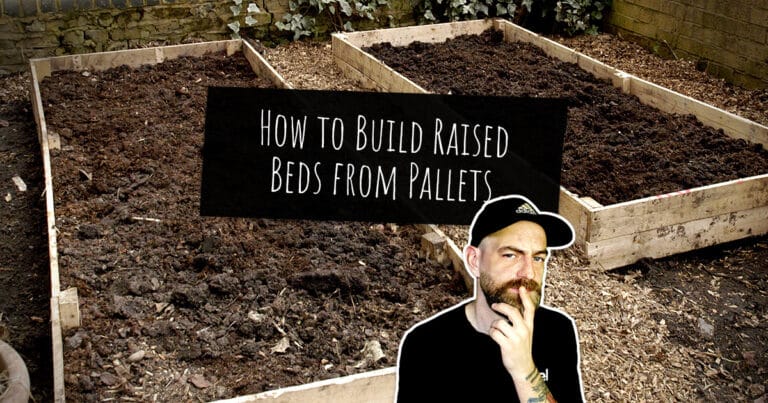Introduction: Building Raised Beds from Pallets
Tired of expensive garden builds? You’re not alone. As timber prices continue to rise, more and more growers are turning to creative, low-cost alternatives that still deliver big results — and raised beds from pallets are leading the way.
Raised beds offer an easy way to:
- Improve drainage
- Control your soil quality
- Grow more in less space
Even better, you can build them without breaking the bank.
In this guide, you’ll learn how to build raised garden beds from pallets — a DIY project that’s easy, affordable, and beginner-friendly.
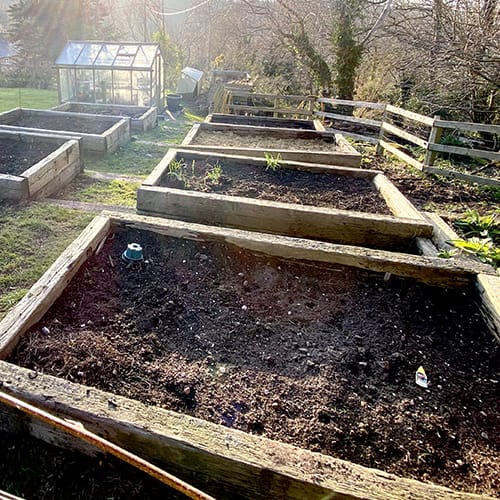
What You’ll Learn:
- How to choose safe pallet wood
- What tools and materials you’ll need
- Step-by-step build instructions
- Tips for maintenance and custom design
👉 Start with our Free Pallet Finder Tool if you haven’t sourced your pallets yet.
Why Use Pallets for Raised Beds?
Building raised beds from pallets isn’t just about saving money — it’s also a practical and eco-friendly way to garden. Whether you’re planning a few pallet raised beds or building a full veg patch, this material offers flexibility, durability, and rustic charm.
If you’re looking for a budget-friendly option that’s easy to source and great to work with, pallets check all the boxes.
Cost-Effective
- Pallets are often free or very cheap to pick up.
- They help you avoid the cost of timber or pre-built raised bed kits.
Environmentally Friendly
- Reusing pallets keeps wood out of landfills.
- It reduces the demand for newly cut lumber.
- Overall, it supports a low-waste, circular approach to gardening.
Functional and Durable
- Many pallets are made from tough hardwoods like oak or pine.
- Since they’re built to carry heavy loads, they make sturdy frames.
- With minimal reinforcement, they can stand up to years of weather.
Rustic Appeal
- Pallet beds bring a handmade, natural charm to your garden space.
- They’re also easy to paint, stain, or customise to suit your style.
When NOT to Use Pallets
- Avoid pallets marked with MB — this means they were chemically treated.
- Skip any that are moldy, cracked, or falling apart.
- Watch out for nails or hardware sticking out that could cause injury.
With a little attention to safety and prep, raised garden beds from pallets can give you a solid, attractive, and sustainable base for growing — all without spending a fortune.
Are Pallets Safe for Growing Food?
This is one of the most common questions when using pallets to build pallet raised beds — and for good reason. While pallets are a great source of reclaimed wood, not all of them are suitable for growing edible plants. Luckily, with a few quick checks, you can easily spot which ones are safe to use.
Decode the Pallet Stamp
Most pallets have a stamp that shows how they were treated. Keep an eye out for these codes:
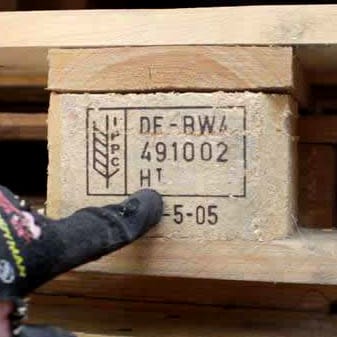
Common Pallet Codes
- HT = Heat Treated (✅ Safe)
- MB = Methyl Bromide (🚫 Avoid — this is a toxic chemical treatment)
- DB = Debarked (neutral, often appears alongside HT)
If there’s no stamp, it’s best to skip it for anything edible.
Pallets to Avoid
- Any marked with an MB stamp
- Pallets that are stained, greasy, moldy, or heavily weathered
- Wood from unknown sources or pallets used for chemical or industrial transport
Pallets That Are Likely Safe
- Clearly stamped HT pallets
- Clean, dry, and free of strong smells or damage
- Ideally sourced from garden centers, retail warehouses, or DIY stores
Cleaning & Prepping Tips
Before using your pallet wood:
Quick Prep Checklist
- Sand rough edges and splinters
- Remove any nails or staples to avoid injury
- Wash with mild soapy water if you’re unsure about residue
- Allow to dry fully before building
In short, pallets can be a brilliant material for raised beds — especially if you’re planning to grow food in raised beds from pallets. Just be sure to choose and prepare them properly. When in doubt, use questionable pallets for ornamental beds or outdoor structures instead.
Tools & Materials You’ll Need
Before you jump into building raised beds from pallets, take a moment to gather the right tools and materials. Being prepared makes the whole process smoother, safer, and a lot more enjoyable.
Essential Tools
What You’ll Need:
- Pallet buster or crowbar – helps dismantle pallets cleanly and efficiently
- Hammer and mallet – useful for loosening boards or tapping nails into place
- Drill and screws – create solid, long-lasting joints
- Tape measure & pencil – for accurate cuts and layout planning
- Handsaw or circular saw – for cutting boards to the right size
Safety Gear
Stay Safe While You Work:
- Work gloves – protect your hands from splinters and sharp edges
- Safety glasses – especially important when cutting or prying
- Sturdy boots – for solid footing and toe protection
Transport & Handling
Getting Materials Home:
- Van, trailer, or roof bars – ideal for hauling multiple pallets
- Ratchet straps or rope – to safely secure your load during transit
Optional Extras
Nice-to-Haves for a Smoother Build:
- Weed membrane or cardboard – helps suppress weeds at the base
- Staple gun – for quickly attaching liners
- Wood sealant or paint – adds durability and personal style
- Level – ensures your raised bed sits flat and even
By getting everything ready in advance, you’ll avoid mid-build scrambles and keep your pallet raised bed project running smoothly. If you’re missing a tool, ask around — borrowing or buying second-hand is a great way to keep your budget in check.
Step-by-Step: How to Make Raised Beds from Pallets
Now it’s time to build. Follow this simple, beginner-friendly guide to create your own raised bed from pallet wood. Most builds take 1–2 hours and only require basic tools.

1. Choose & Inspect Your Pallets
Start by picking out clean, sturdy pallets stamped with HT (Heat Treated). Avoid anything that’s cracked, warped, or marked MB (Methyl Bromide).
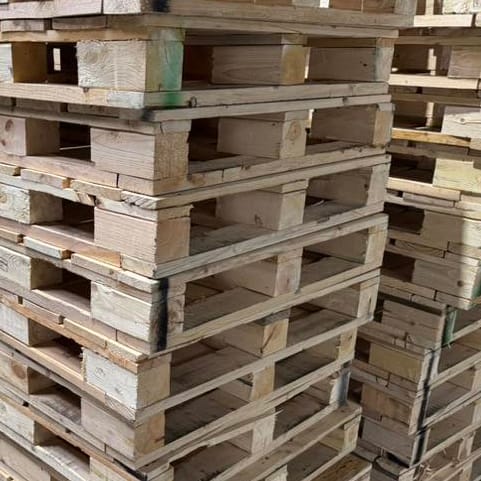
2. Dismantle the Pallets
Break down your pallets using a pallet buster, crowbar, or mallet. Pry apart the slats carefully to avoid splintering. Remove all nails or staples with pliers or the claw of a hammer.
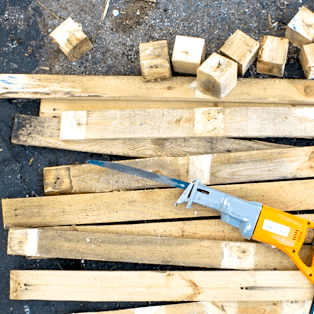
3. Cut Your Wood to Size
Measure out your ideal bed size — a common dimension is 120cm x 80cm x 40cm. Then, cut your pallet boards into side panels, end panels, and corner posts.
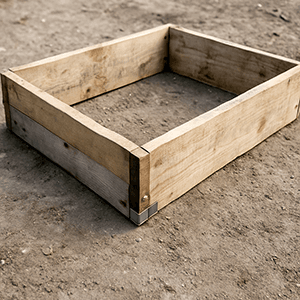
4. Assemble the Frame
Lay the pieces flat and screw them together using brackets for extra strength. Be sure to square off the corners and reinforce weak spots with extra blocks if needed.
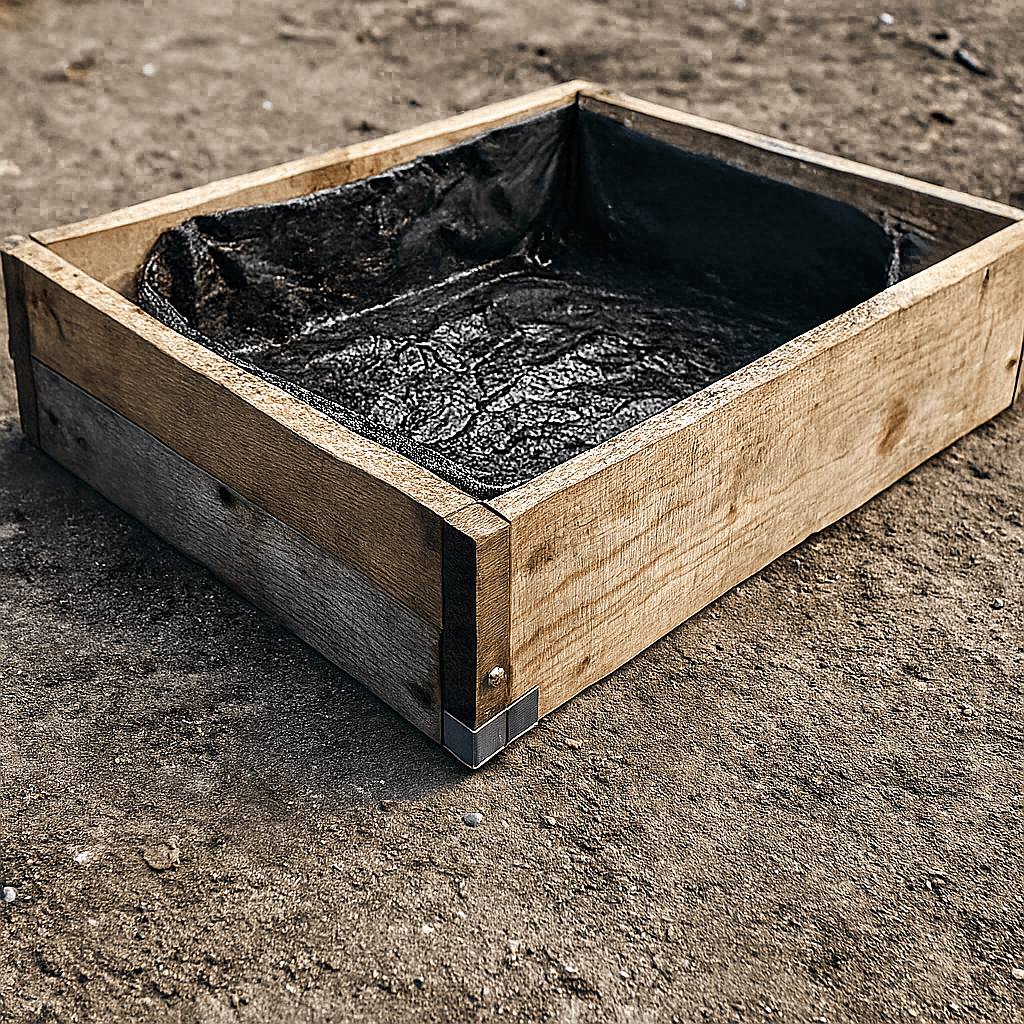
5. Optional: Add a Base or Liner
If you’re placing your bed on concrete or a patio, consider adding a wooden base. Otherwise, line the bottom with cardboard or weed membrane to suppress growth and aid drainage.
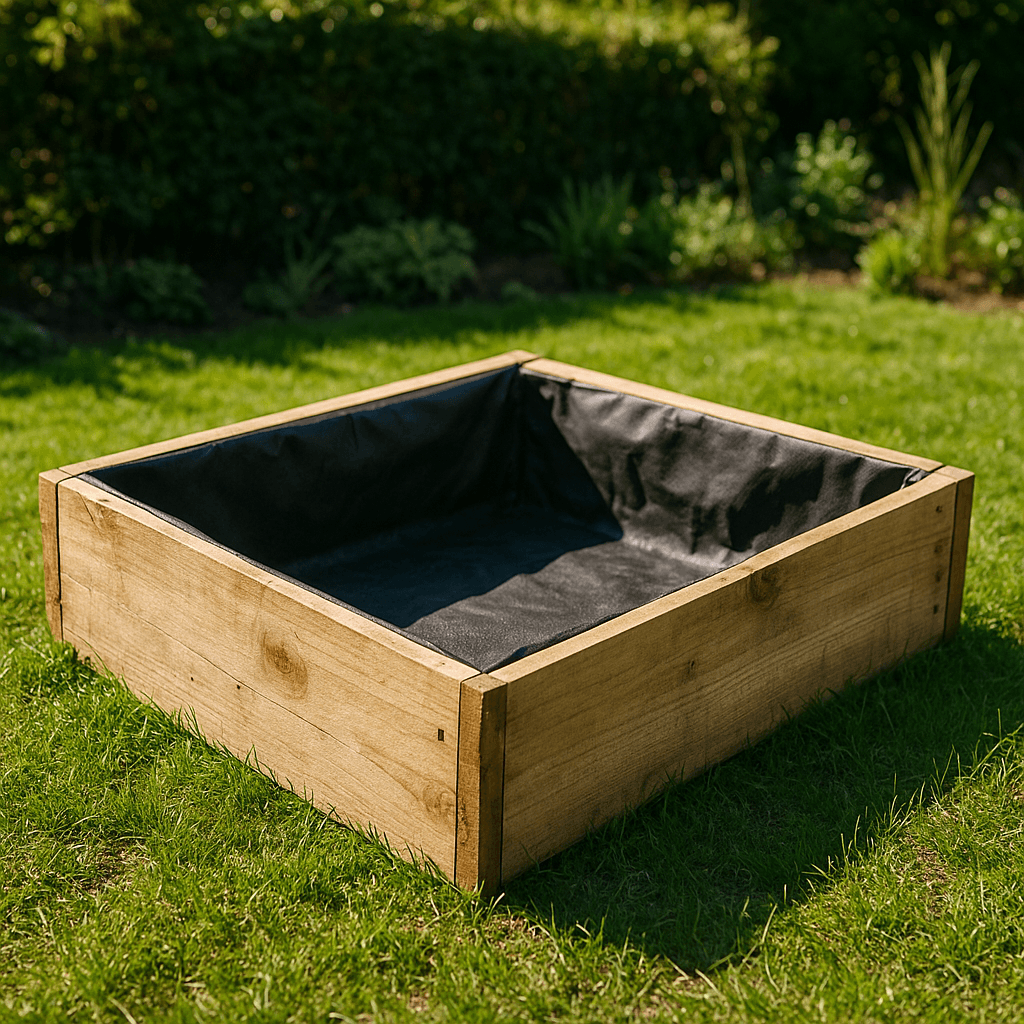
6. Position Your Bed
Move your finished frame into position — ideally somewhere level and sunny. Use a spirit level to make sure it’s sitting flat.
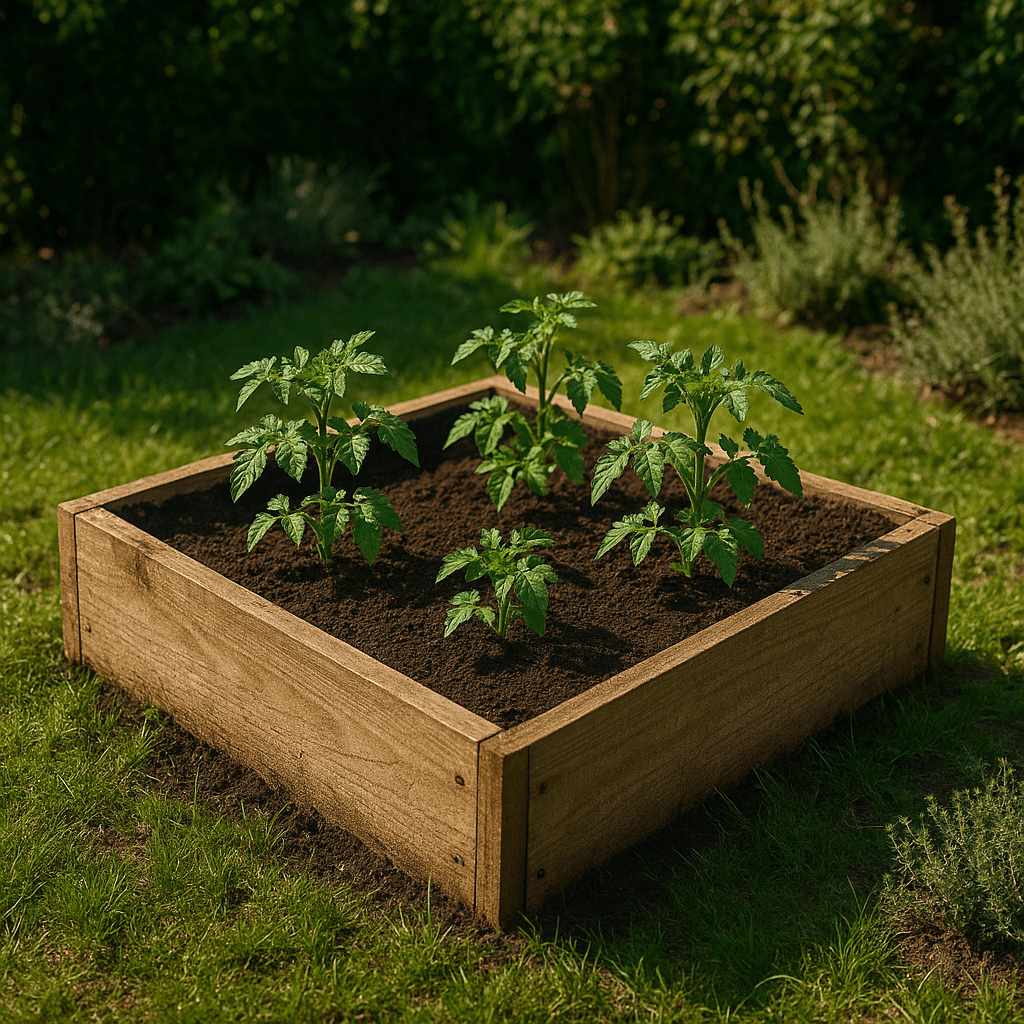
7. Fill & Plant
Layer the bed with sticks or rubble (for drainage), then add compost and topsoil. Water thoroughly, then start planting!
By the end, you’ll have turned waste wood into a beautiful, productive growing space. Whether you’re growing herbs or vegetables, pallet raised beds are an easy, affordable way to expand your garden. It’s a simple project with a big payoff.
Design Ideas and Modifications
After building your first pallet raised bed, you’ll quickly see just how adaptable raised beds from pallets can be. Whether you’re tight on space, catering to specific crops, or looking to add character to your setup, there are plenty of ways to personalise your design.
Different Shapes & Sizes
Make It Fit Your Space:
- Small urban gardens: Try single-board-high beds — perfect for herbs and salad greens.
- Larger spaces: Opt for double-height beds to accommodate deeper roots.
- Modular layouts: Place several beds side-by-side or in rows for a tidy, productive setup.
Easy Access Modifications
Reach Every Plant:
- U-shaped beds make it easier to reach the centre without stepping in.
- Corner L-beds help make the most of awkward spaces.
- Add a central stepping zone in wider beds for better access and maintenance.
Style Upgrades
Add Personality:
- Paint or stain your pallet beds to match your garden vibe.
- Use rope handles, corner caps, or reclaimed hardware for a rustic touch.
- Add a decorative edge using leftover wood offcuts or trim.
Crop-Specific Additions
Customise for Your Plants:
- Install a trellis for climbing crops like peas, beans, or squash.
- Add cold-frame lids to extend your growing season into colder months.
- Fit netting hoops to keep pests at bay without using chemicals.
Need Inspiration?
Take a look at our Pinterest board or browse our photo gallery for real-world pallet bed ideas. From sleek and minimal to upcycled and quirky, there’s something for every garden style.
So whether you prefer bold colours or subtle touches, raised garden beds from pallets give you the flexibility to grow your way.
Maintenance Tips
Pallet raised beds are built to last, but giving them a little care each season can really pay off. With a few simple checks and preventative steps, you’ll keep your beds looking great and functioning well for years.
How Long Do Pallet Beds Last?
Know What to Expect:
- On average, untreated pallet wood holds up for 3–5 years outdoors.
- If you apply sealant or paint, you can stretch that to 5–8 years.
- Beds that stay dry or are slightly elevated tend to last even longer.
Seasonal Maintenance Checklist
Stay on Track Year-Round:
- Spring: Inspect for loose screws, signs of rot, or shifting soil.
- Summer: Refresh paint or sealant if it’s starting to wear.
- Autumn: Clear fallen leaves and trim back nearby plants.
- Winter: Avoid excess moisture and cover bare soil with mulch or fabric.
Preventative Measures
Help Your Beds Go the Distance:
- Line the inside with weed membrane or cardboard to reduce moisture buildup.
- Raise the bed slightly with bricks or stone to improve airflow underneath.
- Once a year, apply a non-toxic wood preservative to the outer panels.
By staying on top of these small tasks, you’ll get the most out of your raised beds from pallets — season after season — while keeping your garden tidy and low-maintenance.
FAQ: Raised Beds from Pallets
Step-by-Step Summary: To get started, dismantle clean, HT-stamped pallets using a crowbar or pallet buster. Next, cut the boards to your desired dimensions and screw them together to form a rectangular frame. You can add a liner if needed, place the bed on level ground, and fill it with compost and soil.
Yes — as long as they’re marked HT (Heat Treated) and free from stains or strong odours. Steer clear of pallets stamped MB (Methyl Bromide) or any that have an unknown or questionable history.
Not necessarily. If you’re placing the bed directly on soil or grass, a base isn’t required. However, if you’re working on a patio or concrete surface, consider adding a wooden slat base or lining the bottom with weed membrane for better drainage.
No — not all pallets are safe. Choose ones that are clean, dry, and clearly marked HT. Avoid anything chemically treated, damaged, or dirty, especially when building raised garden beds from pallets for vegetables or herbs.
Conclusion: Build Smart, Grow Free
Pallets are one of the easiest and most affordable ways to start growing — whether you’re planting herbs on a balcony or setting up a full-blown veg patch. With just a few basic tools, some safe reclaimed wood, and a bit of elbow grease, you can build raised beds from pallets that are not only practical but also packed with personality.
Along the way, you’ll save money, reduce waste, and create a more sustainable garden space — all while giving discarded materials a new lease on life.
✅ Ready to Take the Next Step?
Once your raised beds are set up, why not make them even more sustainable by adding a simple water butt? Our full guide to rainwater harvesting for small gardens in the UK shows you how to collect rainwater safely with a DIY system.
- Download our Free Pallet Checklist PDF (Coming soon)
- Find Free Pallets Near You
- Explore the Firewood Finder Tool
🌱 Final Thought:
Reclaim, rebuild, and grow something great with pallet raised beds that fit your space and style.
